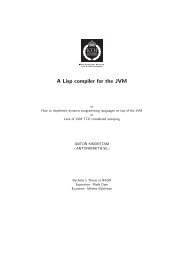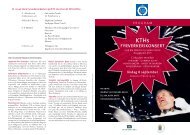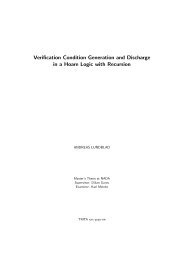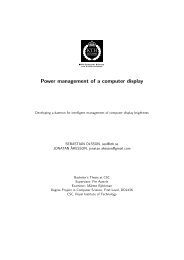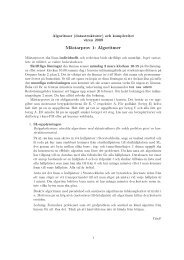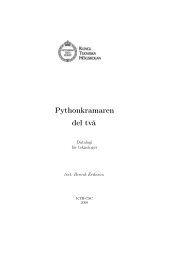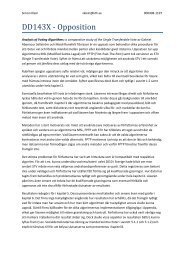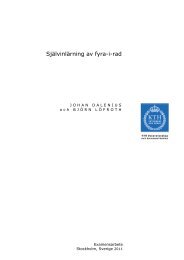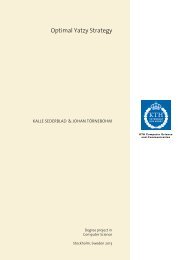The spectrum of delay-differential equations: numerical methods - KTH
The spectrum of delay-differential equations: numerical methods - KTH
The spectrum of delay-differential equations: numerical methods - KTH
Create successful ePaper yourself
Turn your PDF publications into a flip-book with our unique Google optimized e-Paper software.
Abstract<br />
Three types <strong>of</strong> problems related to time-<strong>delay</strong> systems are treated in this thesis.<br />
In our context, a time-<strong>delay</strong> system, or sometimes <strong>delay</strong>-<strong>differential</strong> equation<br />
(DDE), is a generalization <strong>of</strong> an ordinary <strong>differential</strong> equation (ODE) with constant<br />
coefficients. For DDEs, unlike ODEs, the derivative <strong>of</strong> the state at some<br />
time-point is not only dependent on the state at that time-point, but also on one<br />
or more previous states.<br />
We first consider the problem <strong>of</strong> <strong>numerical</strong>ly computing the eigenvalues <strong>of</strong><br />
a DDE, i.e., finding solutions <strong>of</strong> the characteristic equation, here referred to as<br />
the <strong>delay</strong> eigenvalue problem. Unlike standard ODEs, the characteristic equation<br />
<strong>of</strong> a DDE contains an exponential term. Because <strong>of</strong> this nonlinear term, the<br />
<strong>delay</strong> eigenvalue problem belongs to a class <strong>of</strong> problems referred to as nonlinear<br />
eigenvalue problems. An important contribution <strong>of</strong> the first part <strong>of</strong> this thesis is<br />
the application <strong>of</strong> a projection method for nonlinear eigenvalue problems, to the<br />
author’s knowledge, previously not applied to the <strong>delay</strong> eigenvalue problem. We<br />
compare this projection method with other <strong>methods</strong>, suggested in the literature,<br />
and used in s<strong>of</strong>tware packages. This includes <strong>methods</strong> based on discretizations <strong>of</strong><br />
the solution operator and discretizations <strong>of</strong> the equivalent boundary value problem<br />
formulation <strong>of</strong> the DDE, i.e., the infinitesimal generator. We review discretizations<br />
based on, but not limited to, linear multi-step, Runge-Kutta and spectral<br />
collocation. <strong>The</strong> projection method is computationally superior to all <strong>of</strong> the other<br />
tested method for the presented large-scale examples. We give interpretations <strong>of</strong><br />
the <strong>methods</strong> based on discretizations in terms <strong>of</strong> rational approximations <strong>of</strong> the<br />
exponential function or the logarithm. Some notes regarding a special case where<br />
the <strong>spectrum</strong> can be explicitly expressed are presented. <strong>The</strong> <strong>spectrum</strong> can be<br />
expressed with a formula containing a matrix version <strong>of</strong> the Lambert W func-




